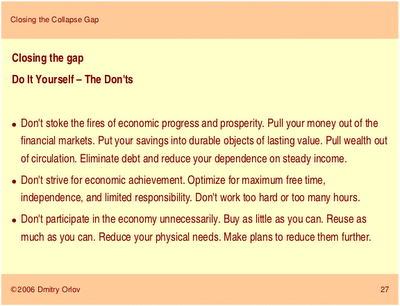Playing the Margins
 "If the economy, and your place within it, is really important to you, you will be really hurt when it goes away. You can cultivate an attitude of studied indifference, but it has to be more than just a conceit. You have to develop the lifestyle and the habits and the physical stamina to back it up. It takes a lot of creativity and effort to put together a fulfilling existence on the margins of society. After the collapse, these margins may turn out to be some of the best places to live."
"If the economy, and your place within it, is really important to you, you will be really hurt when it goes away. You can cultivate an attitude of studied indifference, but it has to be more than just a conceit. You have to develop the lifestyle and the habits and the physical stamina to back it up. It takes a lot of creativity and effort to put together a fulfilling existence on the margins of society. After the collapse, these margins may turn out to be some of the best places to live."
Dimitri Orlov, Closing the 'Collapse Gap': the
I just read Dimitri Orlov's latest piece, which I've quoted from above, on Energy Bulletin and found many interesting and amusing elements to it. I must say that Rob Hopkin's excellent recent entry on peak oil and scared men 'Is Peak Oil Pessimism a Generation of Men Coming to Realise How Useless They Are?' came to mind fairly often. The paragraph above however sparked off some more thoughts about margins.
One of the interesting applications of ecology in permaculture is the phenomena known as the “edge effect”. The "edge effect" is found at the boundaries of two ecological systems where there is more synergism, biological activity, and variations in the microenvironment and which can be used to increase yields in designed systems.
Permaculturists will try to increase the amount of edge in a designed system in order to benefit from this boosted productivity in the ecotone. Techniques for achieving this include making boundaries between areas wavy rather than straight (increasing surface edge), making ponds in irregular shapes or using chinampas.
An interesting extension of the idea of the edge effect has been to lift it out of the physical space in which it is usually discussed into a metaphorical usage. For example some people suggest that it also points to permaculture ideas as being “at the edge" of a change in the push towards a sustainable future. Graham Burnett in Permaculture a Beginners Guide also refers to the importance of marginal or marginalised people, “alternatives” of all persuasion and people
neglected, disenfranchised, discriminated against because of race, religion, sexuality, poverty etc. because they’re single mothers, old, teenagers etc.
Rob Hopkin's comments on the lack of women represented in discussions about peak oil and energy descent, and recent comments by others highlighting the lack of non-white voices in these debates indicate that there is still much work to be done in valuing the "marginal". Gender and race are the most simple examples of how 'difference' can be marginalised. All of this seems to me, to point towards the importance of 'people care' in Permaculture and of social engagement - of recognising what's going on in our local area socially as well as environmentally, and seeing how we might best serve that situation.
IMAGES: Slide 27 from Dimitri Orlov's 'Closing the Collapse Gap', J.Doe (1988) and Lesbian Couple (1988) by Len Steckler.



No comments:
Post a Comment